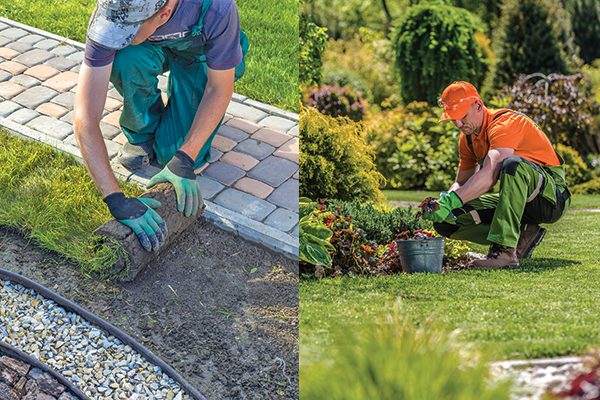Studies show that being surrounded by beautiful green landscapes gives you peace and well-being. In addition to the obvious aesthetic benefits, well-done landscaping protects property and reduces energy use by lowering the need for artificial lighting, heating, and cooling.

Non-woven landscape fabric is a good choice for adding stability and blocking weeds under gravel pathways and rock gardens. It is lightweight and inexpensive. Visit https://www.primecutlawnky.com/ to learn more.
Landscapes are a combination of many different elements, including plants, soil and water. The goal of landscaping is to make the environment around your home look beautiful and appealing. This can be done by using colors, textures and lighting to create a cohesive aesthetic design. You can also use hardscaping to add structure and interest to your yard. This includes things like fountains, firepits and benches. The important thing to remember is that your aesthetic landscape should be safe for everyone. A professional will be able to help you make your yard beautiful without cutting corners or creating a hazard.
The aesthetics of landscaping are influenced by the psychological and cultural factors that influence human perception of environmental scenery. This is the basis of a new field called landscape ecology. Aesthetic preferences for natural landscapes have been correlated with ecological values (e.g. naturalness, pristineness, biodiversity) but are also based on cultural and evolutionary perspectives on nature. However, linking landscape aesthetics to ecological functioning requires accurate measures of both the ecological properties that provoke an aesthetic response and the cognitive processes that interpret these characteristics in the context of human perception.
A good way to create an aesthetically pleasing landscape is by using a variety of plant species, both perennials and annuals. This will ensure that your yard is always looking its best and can also be adapted to the changing climate. It is also important to consider your soil conditions and what type of environment you live in when choosing your plants. For example, high-moisture plants are better suited to wet areas while low-moisture succulents are ideal for dry climates.
While the aesthetics of a yard can be a challenge, it is possible to achieve a stunning and functional space. The key is to choose the right balance of different elements and to make sure that everything is safe for children. It is also important to note that a yard with many different hardscaping elements can be very dangerous for children, especially if they are not properly maintained. Hiring a professional is a good idea to avoid this problem and ensure that your aesthetic landscape is both beautiful and safe for kids.
Health
The benefits of landscaping extend far beyond the beauty of flowers and green lawns. A well-maintained landscape is not only an asset to a home’s curb appeal, but also has the power to positively affect health and wellness.
Healthy landscapes provide food and shelter to wildlife, reducing the need for pesticides and other harmful chemicals in our environment. They help reduce air pollutants, improve the quality of rainwater, and make soil more productive. They also foster a habitat for beneficial insects that assist with crop pollination, while providing food for birds and other animals. Landscapes encourage physical activity by promoting opportunities for walking, jogging or gardening and can increase the amount of time spent outside, which in turn lowers stress levels.
Incorporating a variety of plants and trees into a garden or yard helps to lower blood pressure, relieves mental fatigue, and provides an opportunity for meditation. A home landscape that includes a pond, waterfall or a fire pit can provide a quiet place for reflection and a relaxing retreat from the everyday stresses of life.
A well-maintained and aesthetically appealing landscape can increase property value and allow homeowners to enjoy their outdoor spaces more. Creating a landscape that is a work of art not only adds beauty, but can also improve the overall health and well-being of homeowners, their families, friends and neighbors.
The landscape industry offers many exciting career opportunities for those with a passion for creating beautiful outdoor environments. Landscaping professionals are able to use their creativity, technical knowledge and experience to bring a vision to life while providing a valuable service to clients and the community. Landscaping professionals are often highly regarded as experts in their field and can be found in positions such as grounds managers, project managers, sales executives, corporate executives and business development leaders. There are a variety of educational and training requirements to become a qualified landscape professional, and those with a strong interest in the industry are encouraged to explore their options. Landscaping is an exciting and rewarding career for those who love to be outdoors, are creative, motivated and have a strong desire to contribute to the health and well-being of their community.
Safety
When you think of landscaping, you likely envision the beauty a well-maintained landscape adds to homes and businesses. It boosts property value, makes people feel welcome and attracts customers. But did you know that there are also several safety benefits of landscaping?
A reputable landscaping company makes safety a priority. They provide training and mentoring for new team members to decrease the chances of accidents and injuries. They also take a proactive approach to safety by establishing a culture of safety, which includes the attitudes, perceptions and values that every employee shares with co-workers.
For example, a good landscaping company makes sure that employees are wearing the proper protective gear when working with power tools and equipment. They also train their employees on how to use the equipment safely and inspect their tools on a regular basis to ensure they are in good working condition. They may even hold weekly tailgate safety meetings to consistently remind workers of the importance of being safe.
Landscaping companies may also use a variety of chemicals, pesticides and herbicides to maintain their projects. These chemicals can pose health and safety risks for employees if not used properly, so proper safety precautions must be taken. A reputable landscaping company also provides training on how to handle these substances and how to dispose of them correctly.
In addition to safety training, good landscaping companies have programs in place to recognize their employees who demonstrate a strong commitment to workplace safety. These safety recognition programs can increase morale and create a positive work environment. They can also help employers meet regulatory compliance requirements.
Developing and fostering a safety culture is essential for a landscaping business, as it helps reduce the risk of injury and financial loss for everyone involved. This is especially important when working outdoors, in extreme heat, and using machinery that increases the odds of an accident. In addition, many landscaping companies are working on someone else’s property, which can open them up to a lot of liability. If a landscaping company doesn’t prioritize safety, it could lead to injuries and monetary losses for employees, customers and third parties.
Environment
Landscaping isn’t just about making a property more attractive; it can also help the environment by reducing pollution, conserving water and energy, and creating a habitat for wildlife. Landscapes can also provide health benefits by improving air quality, lowering noise levels, and helping to regulate temperature.
In addition to plants, trees and other greenery, a well-designed landscape can include hardscape elements such as patios, walkways, and retaining walls. These structures add functionality and visual appeal to the yard, and they can be made from a variety of materials including wood, stone, brick, concrete and gravel. Using hardscape features is a great way to reduce erosion and improve the appearance of a home or business, and it can also increase the value of a property.
Sustainable landscaping uses plants and techniques that have a positive impact on the local environment, promoting ecological balance. It also reduces the need for chemical pest controls and relies on water harvesting systems to minimize evaporation. It uses native plants that can thrive in a particular area, which eliminates the need for transporting soil and plantings from elsewhere. It also limits the use of polluting power equipment and gas-powered machinery for maintenance.
A well-maintained commercial landscape can have a positive impact on the environment, increasing the value of a property and attracting tenants. It can also reduce energy costs by shading buildings and lowering the need for air conditioning.
In addition, trees and plants reduce carbon dioxide, a greenhouse gas, by taking it in through photosynthesis and releasing oxygen. This helps to decrease air pollution and improves respiratory health. The calming effects of natural scenery have also been shown to lower stress levels and increase focus and memory.
A healthy and attractive commercial landscape can make your property more appealing to potential customers, boost employee morale, and create a positive image for the company. It can also reduce your operating costs by reducing the need for air conditioning and other energy-consuming technologies. Choosing the right plants and maintaining them correctly can significantly cut down on water and energy consumption.


